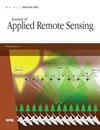Spectral index for estimating leaf water content across diverse plant species using multiple viewing angles
IF 1.4
4区 地球科学
Q4 ENVIRONMENTAL SCIENCES
引用次数: 0
Abstract
Understanding the impact of climate change on Earth presents a significant scientific challenge. Monitoring changes in terrestrial ecosystems, including leaf water content, is essential for assessing plant transpiration, water use efficiency, and physiological processes. Optical remote sensing, utilizing multi-angular reflectance measurements in the near infrared and shortwave infrared wavelengths, offers a precise method for estimating leaf water content. We propose and evaluate a new index based on multi-angular reflection, using 256 leaf samples from 10 plant species for calibration and 683 samples for validation. Hyperspectral indices derived from multi-angular spectra were assessed, facilitating efficient leaf water content analysis with minimal time and specific bands required. We investigate the relationship of leaf water content using spectral indices and apply linear and nonlinear regression models to calibration data, resulting in two indices for each indicator. The newly proposed indices, (R1−R2)/(R1−R3) for linear and (R1905−R1840)/(R1905−R1875) for nonlinear, demonstrate high coefficients of determination for leaf water content (>0.94) using multi-angular reflectance measurements. Published spectral indices exhibit weak relationships with our calibration dataset. The proposed leaf water content indices perform well, with an overall root mean square error of 0.0024 (g/cm2) and 0.0026 (g/cm2) for linear and nonlinear indices, respectively, validated by Leaf Optical Properties Experiment, ANGERS, and multi-angular datasets. The (R1−R2)/(R1−R3) bands show promise for leaf water content estimation. Future studies should encompass more plant species and field data.利用多视角估算不同植物物种叶片含水量的光谱指数
了解气候变化对地球的影响是一项重大的科学挑战。监测陆地生态系统的变化(包括叶片含水量)对于评估植物蒸腾作用、水分利用效率和生理过程至关重要。光学遥感利用近红外和短波红外波段的多角反射测量,提供了一种估算叶片含水量的精确方法。我们使用 10 种植物的 256 个叶片样本进行校准,并使用 683 个样本进行验证,提出并评估了基于多角反射的新指数。我们评估了从多角度光谱中得出的高光谱指数,该指数有助于进行高效的叶片含水量分析,且所需时间和特定波段最少。我们利用光谱指数研究叶片含水量的关系,并将线性和非线性回归模型应用于校准数据,从而为每个指标得出两个指数。新提出的指数,即线性指数(R1-R2)/(R1-R3)和非线性指数(R1905-R1840)/(R1905-R1875),利用多角度反射率测量结果表明,叶片含水量的决定系数很高(大于 0.94)。已公布的光谱指数与我们的校准数据集关系不大。经叶片光学特性实验、ANGERS 和多角度数据集验证,建议的叶片含水量指数表现良好,线性和非线性指数的总体均方根误差分别为 0.0024(克/平方厘米)和 0.0026(克/平方厘米)。(R1-R2)/(R1-R3)波段显示了叶片含水量估算的前景。未来的研究应包括更多的植物物种和实地数据。
本文章由计算机程序翻译,如有差异,请以英文原文为准。
求助全文
约1分钟内获得全文
求助全文
来源期刊

Journal of Applied Remote Sensing
环境科学-成像科学与照相技术
CiteScore
3.40
自引率
11.80%
发文量
194
审稿时长
3 months
期刊介绍:
The Journal of Applied Remote Sensing is a peer-reviewed journal that optimizes the communication of concepts, information, and progress among the remote sensing community.
 求助内容:
求助内容: 应助结果提醒方式:
应助结果提醒方式:


